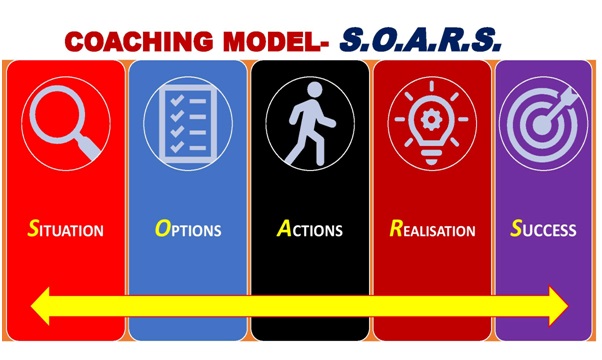A Coaching Model Created by Leslie Yong Kah Hong
(Career Coach, SINGAPORE)

My coaching model SOARS is described as follows:
S= Situation the client is now in
O= Options available to the client
A= Actions to be taken by the client
R= Realisation (achievement) of client’s goals
S= Success
Introduction
Coaching involves partnering with clients in a creative process that motivates them to maximize their potential.
Coaching focuses on helping clients to set goals for their future and helping them to work towards achieving their goals.
Coaching Model
My coaching model provides a framework for the coaching process.
S = Situation the client is now in
As a coach, in my perspective, the first important step is to understand clearly the situation the client is currently in.
Hence coaching session includes the form of explorations, discussions, powerful questioning and active listening to the client.
It is important for the coach to create anew awareness within the client of his current situation, where he or she wants to go from the current situation and how he or she gets there.
Another useful tool to be used by a coach in this initial step of a coaching session is visualisation in which the coach can take the client through a process of seeing, thinking, sensing and feeling their inner motivation and underlying belief and hence helping clients shape their future goals.
As an example, the coach can ask open-ended questions such as “Who, What, Where, How, When questions” to create an awareness in the client about where he has been, where he is now and who he is now and where he desires to be and who he desires to become.
The coach can ask open-ended questions such as “What possibilities does your current situation offer you?” and “How can you challenge your current situation instead of letting your current situation challenges you?”
O = Options
The coach helps clients to determine their realistic and relevant options at this point. The coach facilitates clients to visualise the paths that they can take when they go from the current situation to where they would want to go.
The coach engages clients to leverage on their values, strengths and confidence to enhance their potential and work towards the best possible options.
By employing powerful questions, the coach can ask clients to elaborate on their options they have clearly visualised.
The coach can follow up with the clients to come up with a crystal clear option that they want to pursue.
As an example, the coach can ask “What else” or “What else is coming up for you?” to enable the client to evaluate what other options he may be thinking of and what is most important to him, what his passions and purposes that are clear to the client.
A = Actions
At this point, the coach assists the client to determine his action plans to achieve his goals. The coach helps the client to develop that clarity of his mind to share what he intends to do and achieve for his future. Based on the options selected by the client, the coach partners with the client to help him establish an action plan that is aligned with his or her goals and objectives.
The action plan shared by the client must include a deep sense of commitment and accountability to the client. The coach must be able to help the client unite the client’s underlying positive beliefs and strengths towards achieving his or her goals.
The client takes on incremental steps to set short term and long term goals to further his journey towards achieving the goals.
The coach facilitates the client such that the client embraces his own accountability as he journeys through his action plan process.
As an example, the coach can ask open-ended questions such as “Who questions” to further understand the support structure or people who will support the client in his action plan and help the client to be accountable to his own action plan.
The coach can further ask open-ended questions such as “What questions” namely:- What are you trying to achieve through these actions? and “What is challenging to you?” or “what might get in your way?”
R = Realisation of Client’s Goals
The coach supports the client to determine his next steps in moving forward towards his desired goals.
The coach further facilitates the client to take action and reach his goals.
The coach creates awareness in the client to empower himself to take responsibility and ownership of his actions that lead to future success.
The coach further communicates directly with the client to look deep within himself as to what his attitudes, behaviours and habits that will impede his progress towards reaching his goals.
As a coach, it is important to facilitate the client to leverage his strengths to work out a consistent action plan to achieve his goals.
It is useful to ask open-ended questions such as “How questions” namely: “How would you strategise your first 3-month action plan into achieving your quarterly milestones.” “How did you know you have achieved your quarterly goals?”
S =Success
The coach continuously shows concern and support to check on the client’s accomplishment at every milestone.
The coach can ask open-ended questions such as “What have you accomplished since the last session?”, “What are the obstacles that you are facing and what you would like to further discuss?”, “What has stopped or prevented you to achieve your goals?” and “How did you know you have accomplished your goals?”
The coach can facilitate the client to ascertain whether his goals are short term or long term.
The coach can ask the client such question “What do you wish to achieve in the long term?”
In closing the coaching session, the coach needs to check in with the client eighth questions like“How successful have you been now with regards to your outcome?”,“What is your learning take away from this session?” and “How would you apply this learning?”